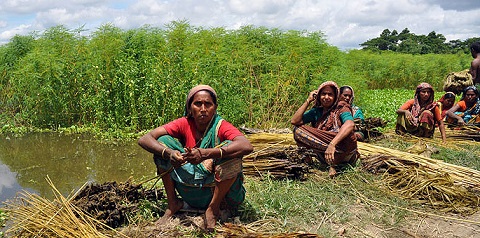Superfund Research Program
Genetic Epidemiology of Neurodevelopmental Metal Toxicity
Project Leader: David C. Christiani
Grant Number: P42ES016454
Funding Period: 2010-2015
![]()
Project-Specific Links
- Project Summary
Final Progress Reports
Year: 2013

Field workers at one of the study sites in Bangladesh. (Photo courtesy of Harvard)
In 2013, Dr. Christiani and his research team completed genotyping data generated by the Illumina 700K for the Bangladesh cohort. They cleaned up phenotype data for this cohort and merged the data with genotype data. The data clean up and merge were completed in March. The researchers are conducting genome-wide gene by environment (GxE) interaction scans on each cohort separately to identify SNPs that change the response to prenatal metal exposure (Mn or Pb) on fetal growth, i.e., birth weight and head circumference. The researchers have identified top SNPs and genes, and are conducting an extensive literature and EQTL database search to verify that these genes are related to fetal development. Also underway is the longitudinal analysis of Bayley scores to identify genetic variants that modify the response to prenatal metal exposure (Mn or Pb) on neurodevelopment, using genome-wide association study (GWAS) data now from both the Mexico and Bangladesh cohorts. Meanwhile, phenotyping continues at one site: Bangladesh, with Mexico and Tar Creek. With genome wide data on both cohorts, the researchers will be better able to account for ethnic differences, and they obtained a deep discount on genotyping from the Broad Institute of Harvard and MIT. These data are in the QC pipeline. The researchers also imputed the whole genome in both cohorts and thus have thorough information on population stratification. They are harmonizing phenotypes (e.g. Bayley scale at 24 months) and working on GxE analysis by each metal, as well as working with the Optimizing Sampling and Statistical Analysis for Hazardous Waste Site Assessment project on assessment of GxE using Dr. Brent Coull's kernel machine method for estimating multiple exposures simultaneously. Interesting, the top GxE SNP and gene hits do show overlap in the two populations.
SignificanceThe project researchers have met their overall recruitment goal of 1,000 children for the Discovery population in Mexico, and have evaluated 827 children in Bangladesh, which became their revised goal from the original 1,000 children after budget cuts and other unforeseeable issues arose. Those individuals with complete genotype and phenotype (24 month) data and passing QC, are about 800 in each cohort.


